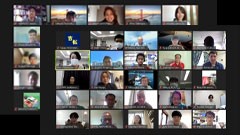Used as pre-learning materials for online seminar
JICA produced JICA-Net multimedia-based learning material "Fisheries Value Chain in Japan" (external link) to understand the effectiveness and peculiarities of Japanese fisheries value chain, which efficiently combine diverse fish catches and consumption patterns to create added value, and points to keep in mind when people introduce Japanese experiences into their own country.
This time, we used this material as a pre-learning to learn practical examples of Japanese fisheries value chain in online seminar "Development of fisheries in Japan" for JICA international students in the field of fisheries, which was held on June 27th, 2021.
Learning about various efforts of the Japanese fisheries value chain

A variety of fisheries resources is indispensable for Japanese food culture.
In Japan, a country surrounding by water, where people have developed a unique food culture centered on a variety of fisheries resources, stakeholders of fisheries industry have made enormous efforts over the years for the qualitative improvement of the fisheries value chain and the diversification of distribution channels. Fish and marine products are delivered from local fishing ports or fish importers, traded at production area wholesale markets, and distributed to consumption area wholesale markets. They go through fish retailers, supermarkets, restaurants and others before reaching consumers and enriching Japanese dietary life.
In the first half of "Fisheries Value Chain in Japan" explains those mechanisms and roles with many illustrations and videos that are showing the field and enable people to learn an outline of fisheries value chains. In the second half, it introduces the new efforts to add value with some successful examples in various places of Japan, such as challenge for quality control and assurance by new technology of low-temperature preservation, "Sixth industry" development that means fishermen process and retail by themselves, creation of local brands and ecolabels, and cooperation with tourism.

Toyosu Market; There are a wide variety of fish and fishery products gathered from regional wholesale markets all over the Japan.
The material is comprehensible for everyone

70 students participated the online seminar.
There were 70 students who participated the online seminar, not only JICA international fisheries students, but also other international and Japanese students. The material introduces fisheries value chain in an easily way by using plain words, illustrations, and videos, and shows advanced efforts as well as points to keep in mind. It did not seem that difficult for students. I think they were able to efficiently understand the main points in the 25-minute video.
We were preparing to start an online seminar for JICA international students in the field of fisheries while we were producing the material. So, we intended to use the material for the seminar as prior learning from the beginning. JICA is planning to accept long-term trainees continuously, so we will use the material when trainees come to Japan as an introduction. This material can be widely used not only for trainees of JICA Knowledge Co-Creation Programs, JICA long-term trainees, international students who are interested in fishery development experiences in Japan, but also as public relations for the explanation of fisheries value chain. I expect that Japanese knowledge and experiments elaborated in fisheries value chain became an aid for various countries in the world.
Masaru Honda
JICA Economic Development Department
*The Material(s) mainly applied
Fisheries Value Chain in Japan
This material explains how Japanese fisheries increase the value of their products by focusing the points below. -Cold chain technology and distribution system from the fishing boat to the table of consumers -Safety, hygiene and quality inspection and HACCP -Marketing with fishermen's market, tourism collaboration, local branding and ecolabelling




scroll